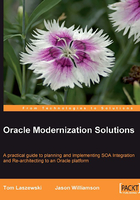
Where to Begin — a Word on Application Discovery
Once we have identified our business drivers, and some of the first steps in this process, we must understand what we have before we can modernize it. Legacy environments are very complex and quite often, have little or no documentation. This introduces a concept that is true for any modernization technique to be used — Application Portfolio Analysis (APA). In the introduction chapter, we discussed the importance of APA and mentioned that every modernization project must begin with this stage. Remember, the key to application discovery is leveraging technologies that will provide a repository for leveraging the business logic contained in the core legacy systems. In practical terms, this means that if we are to leverage legacy assets, we will greatly benefit from being able to interact with a repository of the metadata derived from these legacy assets.
In the next chapters, we will explore how we can open up a legacy system for SOA integration, and take the next step to a re-architected system by leveraging this valuable repository. The following figure illustrates the APM process:

Currently, the Oracle Modernization Alliance has several partners that can enable a repository-based solution for APA.

Assessment Process: Bringing it together
While it is very important to understand in detail how legacy code such as JCL, COBOL, and Copy Books is parsed, and enabled for SOA services, it is equally important to briefly outline a sample workflow of steps to show how one of these legacy repositories can be leveraged into our overall SOA Strategy. So, as we utilize these technologies to SOA to enable our legacy application, we will outline some key stages that need to be integrated into the development cycle and modernization roadmap. Determine the business case.
We can break this SOA analysis into three stages:
- Determining the requirements
- Understanding Legacy
- Defining Roadmap
The following diagram illustrates the workflow steps involved in the technical assessment of a system using a technology from an APA vendor. Each phase of this scoping will enable you to build a business case for which processes will be good candidates for SOA enablement.

Summary
In this chapter, we laid the foundation for Legacy Modernization through SOA enablement. The key concepts we discussed were:
- SOA context of the legacy
- Techniques for SOA enablement of the mainframe
- Key drivers for SOA enablement
- High-level approach to SOA projects
Now let's roll up our sleeves and get into some technology!